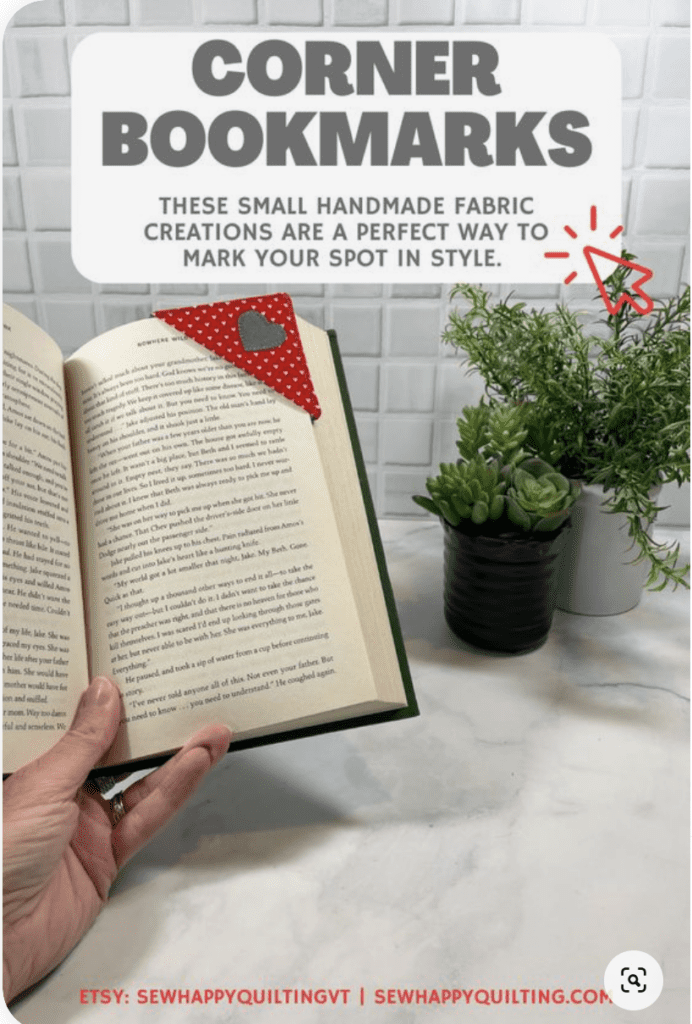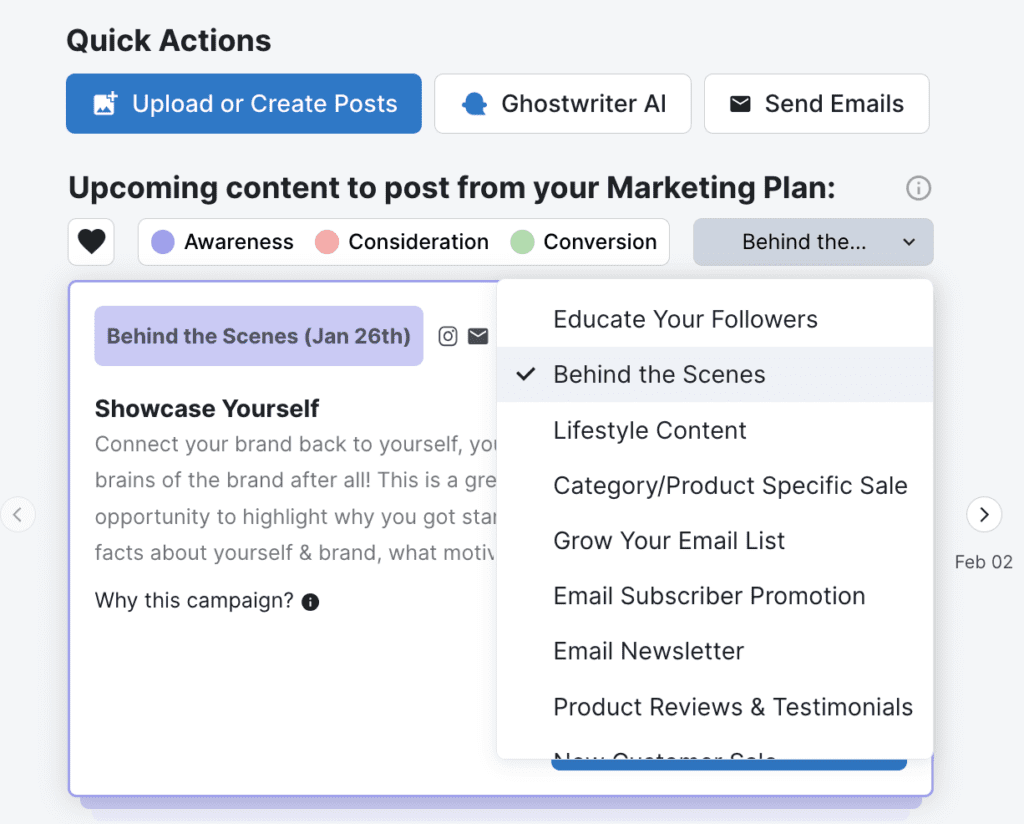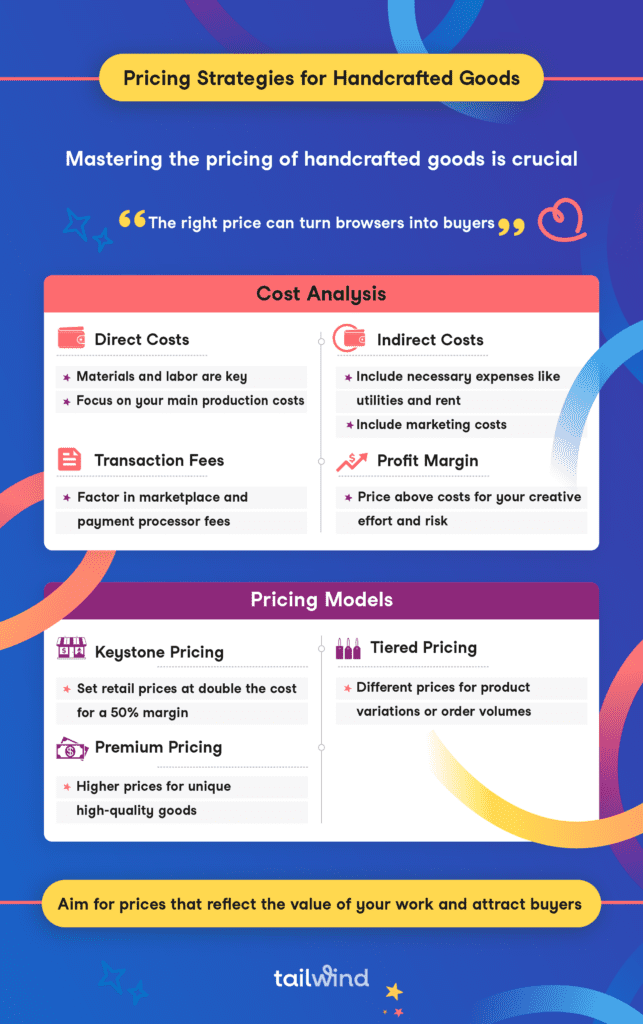
Markets are saturated. There is a store for anything and everything, and if you can’t find it now, rest assured that soon a dropshipping ecomm store will pop up.
But there is a way to stand out, be different, and make a name for yourself while keeping control of all the phases of ecommerce trade!
In this post we will cover how to create your own handcrafted goods, how to market them, sell them and turn your customers into repeat customers!
Understanding the Handcrafted Goods Market
The market for handmade products is diverse and can vary greatly by category — from handmade jewelry to home decor.
As an artisan, recognizing which categories are in demand can help you tailor your offerings.
Identifying your target audience is a critical step.
Different marketplaces attract different demographics, and understanding this can lead to better sales strategies.
Online marketplaces such as Etsy or Amazon Handmade are popular options that cater to a vast audience looking for unique, handcrafted items.
Competition in the handmade goods market is notable. You’ll find a wide range of artisans selling handmade items similar to yours.
To stand out, focus on the uniqueness and quality of your products. Developing a niche may also reduce direct competition and attract a dedicated customer base.
Here are key points to consider:
- Marketplaces: Choose the right online marketplace that aligns with your brand and has the audience you aim to reach.
- Categories: Understand popular categories to possibly enter a less competitive space or capitalize on a trend.
- Audience: Know who is buying handmade goods and tailor your marketing to speak directly to them.
- Sales: Track what works. Adjust pricing, presentation, and promotion based on sales feedback.
By understanding these aspects, you position yourself as a knowledgeable handmade seller with the potential to carve out a successful niche.
Creating Your Handcrafted Products
Creating exceptional handcrafted products begins with selecting superior materials and fostering creativity in your designs, while maintaining a steadfast commitment to quality and consistency.
Choosing the Right Materials
When selecting materials for your handmade crafts, prioritize durability and aesthetics. Ensure your materials reflect the quality and value of your artisan work.
- Natural Materials: Often provide a unique texture and an organic feel to your craftsmanship. Examples include wood, leather, and clay.
- Synthetic Materials: Choose high-grade options that enhance the product’s functionality and longevity.
Developing Unique Designs
Your creativity sets your handcrafted items apart. Cultivate a distinct style that resonates with your target audience.
- Originality: Strive for designs that are both innovative and personal to showcase your artistry.
- Trends: Stay informed of current trends, but don’t compromise your artistic integrity. Use trends to inspire — not dictate — your designs.
Ensuring Quality and Consistency
Quality control is crucial in establishing trust with your customers. Ensure that each piece meets a high standard.
- Inspection: Regularly examine your work at various stages to safeguard against defects.
- Consistency: Develop a system to produce items that are consistent in look, feel, and function.
Branding and Marketing Your Handcrafted Goods
To effectively sell your handcrafted goods it’s important to focus on developing a strong brand identity and implementing savvy marketing tactics to reach your target audience.
Establishing a Brand Identity
When you create your brand you’re telling the story of your handcrafted goods. Begin by choosing a name and logo that resonate with the spirit of your work. This visual representation will become the cornerstone of your brand’s identity. Ensure that your packaging and any promotional materials consistently reflect your brand’s aesthetic and values. Networking within a community can bolster your brand’s reputation, instilling trust and fostering loyalty among your customer base.
Online Marketing Strategies
Your online presence is pivotal for exposure. Setting up a user-friendly website is a must, which acts as the digital storefront for your handcrafted goods.
- Consider using online marketplaces known for handmade items (such as Etsy) to reach a wider audience.
- Email marketing is an effective tool to keep your audience engaged with newsletters and exclusive offers directly reaching their inboxes.
- Make sure to start collecting emails from day one.
- PPC/Paid Search: Start testing visuals and audiences as soon as possible. Test thoroughly, but do not get stuck on just one platform. Make sure to test as many as possible.
Leveraging Social Media for Handcrafted Goods
Social media platforms are invaluable for marketing your handcrafted goods. Use Instagram and Pinterest to showcase your products through high-quality images and hashtags to increase your visibility.
Check out this Pin from SewHappyQuilting.com

The image clearly highlights what the product is and the background and Pin color scheme all work together to call attention to the product. Because a corner bookmark is a novel product, it’s a great idea to showcase how it’s used.Engage with your followers regularly by responding to comments and sharing behind-the-scenes content.
Check out this behind-the-scenes Instagram Reel from Handpainted by Cookie.

“A quick tip to create lots of behind the scenes content is I set up my tripod in my workshop while I am working, put it on time lapse, and hit record.
“Then at another time I edit it into 5-second clips and put it in different folders. I sort them by project or products used or evergreen (something timeless).” Miriam Ventura, @handpaintedbycookie.
And, this post features the progress that Jolene Airey from HomeStitcheryDecor.com has made in her business, using an image of her newest tech purchase:

If you need other ideas about how to create great behind-the-scenes content, check out the prompts in Tailwind Copilot — filter to find behind-the-scenes content you can use right away.

On Facebook, join groups that cater to enthusiasts of handcrafted goods and participate in discussions to build a community around your brand.
Ads can be targeted to reach a specific target audience based on demographics and interests, leading to higher conversion rates for your handcrafted business.
Last but not least — TikTok. It is THE place for a consumer brand (even more so if you are marketing towards younger demographics), so make sure to establish a strong presence there.
Setting Up Your Online Store
When creating an online store for your handcrafted goods, selecting the appropriate ecommerce platform is crucial for ease of use and maximizing sales, while SEO plays a vital role in driving traffic to your products. Efficient inventory and order management will simplify the selling process.
Choosing the Right Ecommerce Platform
To establish a successful online store, it’s essential to choose an ecommerce platform that aligns with your business needs. Etsy is a popular choice for handcrafted items, offering a specialized marketplace with a built-in audience interested in unique, handcrafted products. Amazon Handmade is another option, allowing access to a vast customer base, though it can be highly competitive. Both of these platforms charge listing and transaction fees — usually a percentage of your sales.
Alternatively, Shopify provides a comprehensive platform where you can set up a personalized store with greater control over branding. It comes with different subscription levels and payment processing fees, but it offers a range of tools geared towards business growth.
When choosing a platform, consider factors like fees, audience, and the level of customization you require.
| Platform | Fees | Audience | Customization |
| Etsy | Listing + Transaction | Niche (Handcrafted goods) | Low |
| Amazon | Listing + Transaction | Broad | Low |
| Shopify | Subscription + Payment | Broad | High |
Optimizing Product Listings for SEO
Once your ecommerce platform is chosen, focus on optimizing your product listings for search engines to increase visibility.
Use relevant keywords in product titles, descriptions, and tags to allow potential customers to find your items through search. High-quality images and detailed descriptions not only provide clarity to buyers but also contribute to SEO.
Platforms like Etsy and Shopify offer insights into which terms are being used to search for products like yours, which can guide your keyword incorporation.
- Product Title: Include primary keyword(s) at the beginning.
- Meta Descriptions: Concise and compelling with relevant keywords.
- Images: Use alt-tags and descriptive file names.
Managing Inventory and Orders
An organized approach to inventory and order management ensures a smooth operation.
Most online marketplaces and ecommerce platforms offer tools to track inventory levels and manage orders.
Implement a system that notifies you when stock is low to prevent overselling. On platforms such as Etsy or Shopify, you can integrate apps that assist with inventory management, while Amazon provides comprehensive order fulfillment services if you opt for Fulfillment by Amazon (FBA).
Effective management includes:
- Tracking inventory levels within the ecommerce platform.
- Utilizing alerts for low stock.
- Streamlining the order fulfillment process — from receiving the order to shipping.
Pricing Strategies for Handcrafted Goods
In the realm of selling handcrafted goods, the determination of an optimal price point is crucial. It requires a balance between covering costs and remaining competitive — all while ensuring profit generation.
Cost Analysis and Pricing Models
Conduct a thorough Cost Analysis to determine the baseline for your pricing. Account for materials, time, and overheads. Consider the following:
- Direct Costs: These are the costs associated with the production of your goods (e.g. materials, labor).
- Indirect Costs: These include overheads like utilities and rent.
- Transaction Fees: Remember to factor in any transaction fees that marketplaces or payment processors may charge.
- Profit Margin: Add a profit margin on top of your costs to ensure sustainability.
Employ different Pricing Models which can include:
- Keystone Pricing: Doubling the cost of goods to set the retail price.
- Tiered Pricing: Offering different prices based on product variations or order volume.
- Premium Pricing: If your handcrafted goods are of high quality or uniqueness, setting a higher price point may attract customers looking for premium products.

Competitive Pricing and Market Trends
Assess the competition to set a price that is both fair and competitive. Research marketplaces such as Etsy, or attend craft fairs to gauge the pricing landscape. Keep these factors in mind:
- Market Trends: Are consumers currently willing to pay a premium for certain types of handcrafted goods?
- Competition: What are your direct competitors charging for similar items?
- Price Sensitivity: Determine how sensitive your customers are to price changes.
Consider external services such as Fulfillment by Amazon (FBA), which can impact your pricing due to the fees associated with storage and shipment.
| Service | Fee Type | Impact on Pricing |
| Payment Processor | Transaction Fee | Increase Item Price |
| Marketplace Listing | Listing Fee | Factor into Overheads |
| Fulfillment by Amazon (FBA) | Fulfillment Fee | Adjust Price Accordingly |
By implementing these pricing strategies you’ll be able to price your handcrafted goods competitively and sustainably.
Selling Handcrafted Goods at Local Markets and Events
Participating in local markets and events can significantly increase the visibility of your handcrafted goods.
By focusing on striking booth presentation, selecting the right venues, and developing customer relationships, you can grow your sales and establish a strong community presence.
Important: We assume that your main distribution channel is online sales, but events can play a great role on them as well. Make sure to get as much marketing material as possible so you can recycle it for the next year!
- Photos
- Videos
- Interviews with customers
- Live stream while selling
The list goes on!
Finding the Right Venues
When you’re looking for venues to sell your handcrafted goods, consider the type of market or event that aligns with your brand and products.
Research local events, seasonal fairs, and farmers’ markets to identify opportunities with high foot traffic and a relevant customer base. Check the event’s history, past vendor experiences, and customer demographics to ensure a good fit. Utilize the following table to organize your venue prospects:
- Event Name
- Date
- Audience
- Expected Traffic
- Vendor Fee
Booth Setup and Presentation Tips
Your booth should attract and retain the attention of attendees. Use clear signage with bold lettering to display your brand name and the nature of your handcrafted goods.
Ensure that your products are accessible and presented attractively, offering a tactile experience for customers.
A structured layout with distinct areas for different product types helps in navigating your booth. Consider the following checklist for your booth setup:
- Signage: Clear, visible, and readable from a distance.
- Display: Tiers and shelves to create an attractive layout.
- Accessibility: Open paths for customers to browse and interact.
- Lighting: Adequate lighting to highlight your products.
Networking and Building Customer Relationships
Attend events not only to sell but to connect with customers and other vendors. Engage in conversations to understand customer needs and to collect feedback to improve your products.
Offer a mailing list sign-up to keep interested parties informed about new products and future events. Building relationships in the community can lead to customer loyalty and word-of-mouth marketing, which are invaluable for your brand. Here are key networking strategies:
- Engage with customers and ask for feedback.
- Collaborate with other vendors to cross-promote.
- Follow up with leads post-event to nurture relationships.
Shipping and Customer Service
To excel in the handmade goods market, streamline your shipping and provide stellar customer service to cultivate loyalty and ensure customer satisfaction.
Efficient Packaging and Shipping Methods
When preparing orders for shipping, select packaging that ensures the safety of your products while keeping costs manageable.
Consider using Fulfillment by Amazon (FBA) to leverage their expertise and infrastructure, saving you time and potentially reducing overhead. Utilize carriers that offer reliable tracking systems, enabling you to keep customers updated with their order status.
- Choose durable, lightweight packaging to minimize shipping costs.
- Offer multiple shipping options to meet various customer preferences.
Handling Customer Inquiries and Complaints
Prompt and empathetic handling of customer inquiries and complaints is the cornerstone of effective customer service. Implement a clear support system for customers to reach you and ensure their issues are addressed quickly.
- Set up an automated response acknowledging receipt of customer inquiries.
- Resolve complaints with solutions that prioritize customer satisfaction and retention.
Building Repeat Business through Excellent Service
Repeat business is critical for long-term success. Achieve this by going beyond the expected with your service.
Send personalized follow-up messages to confirm customer satisfaction and encourage feedback, engaging customers in a way that makes them feel valued.
- Create a rewards program for repeat customers.
- Solicit feedback to demonstrate your investment in continuous service improvement.
Scaling Your Handcrafted Business
Effectively scaling your handcrafted business requires a combination of expanding your product range, tapping into wholesale opportunities, and implementing robust growth strategies. These steps are crucial for reaching more customers and increasing your market presence.
Expanding Product Lines
Product Diversity: To capture a wider audience, diversify your offerings. This might involve:
- Seasonal items to attract customers during specific times of the year.
- Limited editions, which create a sense of urgency and exclusivity.
Customer Feedback: Leverage customer input to understand demand and introduce products that resonate with potential customers.
Strategies for Long-Term Growth
Multi-Channel Sales: Develop a presence across several sales channels. Online marketplaces, your own ecommerce website, and physical storefronts each attract different types of customers.
Affiliate Programs: Partner directly with an affiliate, join an affiliate marketing platform, or create your own affiliate program — there are many ways to leverage other marketers to help you sell your product!
Partnership Development: Consider partnerships with retailers to sell your products in their stores. This step can rapidly increase your brand’s visibility. Create a wholesaler packet, including:
- A product catalog
- Wholesale pricing (ensure this allows for a profitable margin while being attractive to retailers)
Marketing and Brand Development: Consistently promote your brand through:
- Social media campaigns
- Email marketing
- SEO for your online content
Operational Efficiency: Streamline production and fulfillment processes to handle increased orders without compromising quality.
Remember, methodical planning and execution pave the way for the successful scaling of your handcrafted business.







